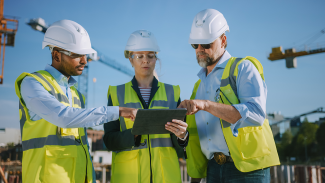Having helped develop policies and processes around safety in design for three decades, expert and long-time trainer John Giles outlines his approach to modern safety in design.
The below article was first published by Create Digital.
After a workplace death, as the organisation went through the process of figuring out what went wrong, and how such a tragedy can be avoided in the future, John Giles was called in to consult.
“I asked to have the team of designers in the room, but I also asked to have the operators in the room,” says Giles, Trainer in Safety in Design for Engineering Education Australia (EEA), and Principal of Appleseed Engineering.
“The designers said, ‘We designed it this way.’ The operators said, ‘Well, we knew it was a bad design and we knew it could potentially kill people.’
“I asked the question, ‘Well, why didn’t anybody talk to anybody about this?’ It was as if both parties were at war. The solution was about having a discussion and spending around $200 to change a part of the process. But instead, somebody was killed.”
Many safety in design solutions are simple, says Giles. When he first began working in the safety field, with engineering services firm UGL, his task was to help reduce worksite accidents.
He became aware of a lot of unnecessary injuries, such as workers nailing their feet to the floor with nail guns or injuring themselves while using cut off saws. All of these serious risks had simple solutions that hadn’t yet been put in place.
“Most of that was easily fixed,” he says. “With the cut off saws, for example, we simply banned them. Instead, we insisted the item was designed correctly in the first place, so it didn’t have to be cut on site. That got rid of all of those injuries.”
Safety in design isn’t just important, it’s a requirement under the law. Different legislation applies across Australia’s different states and territories, but section 22 of the Work Health and Safety (WHS) Act 2011 is illustrative. It states that designers “must ensure, so far as is reasonably practicable, that the plant, substance or structure is designed to be without risks to the health and safety” for the people that use or are involved in its construction.
All it takes is a conversation
The UGL experience revealed to Giles the simple fact that success in safety in design is determined by communication. It’s about designers consulting with operators, builders, other contractors, and so on.
“I got involved in developing procedures and processes and that grew into safety in design as we know it. My definition of safety in design is designing things that people can safely operate, construct, maintain and demolish,” says Giles.
“It’s not just about making a unique design, such as a building that’s going to stand out. It’s about ensuring that when I come to clean the windows, I can do that safely. Engineers sometimes forget about the back end of the job, that somebody is going to have to maintain it, operate it and demolish it.”
Giles’ ideal approach involves building consultation into every step of the design process. It also calls on designers to get out of their offices and into the environment in which their design becomes reality.
“Sometimes builders receive a design and ask, ‘Who designed this rubbish?’,” Giles says. “Sometimes designers get upset because builders change their designs. It’s extremely important that designers communicate the reason they designed something a certain way.
“If they don’t, that’s when you get major catastrophes like the Granville train disaster or the West Gate Bridge collapse. Nearly all such disasters are to do with lack of communication.”
Giles refers to the 2019-20 bushfires as another example where simple principles could have helped.
“So much infrastructure was designed in the middle of forests. As a result, there was no mobile phone reception due to power loss, when people needed it most. If we get the right people in a room together, and we run risk workshops before the design is done, rather than afterwards to tick a box, we’ll have better outcomes.”
In 2020 in Australia, 182 people were killed at work. Giles would like to see that figure dramatically reduced. And that’s just a start, he says, because safety in design is about more than that. It’s about user-friendly design and about ensuring artificial intelligence is making the right decisions. It’s about making sure medical instruments work safely in the operating theatre.
In other words, it’s not just related to construction engineering.
“How do we value human life and experience?” Giles asks. “If we focus on user experience, on the outcome for the user, we will naturally succeed in safety in design.”
To improve your own skills in Safety in Design and gain insights from John Giles, join our on-demand short course.
